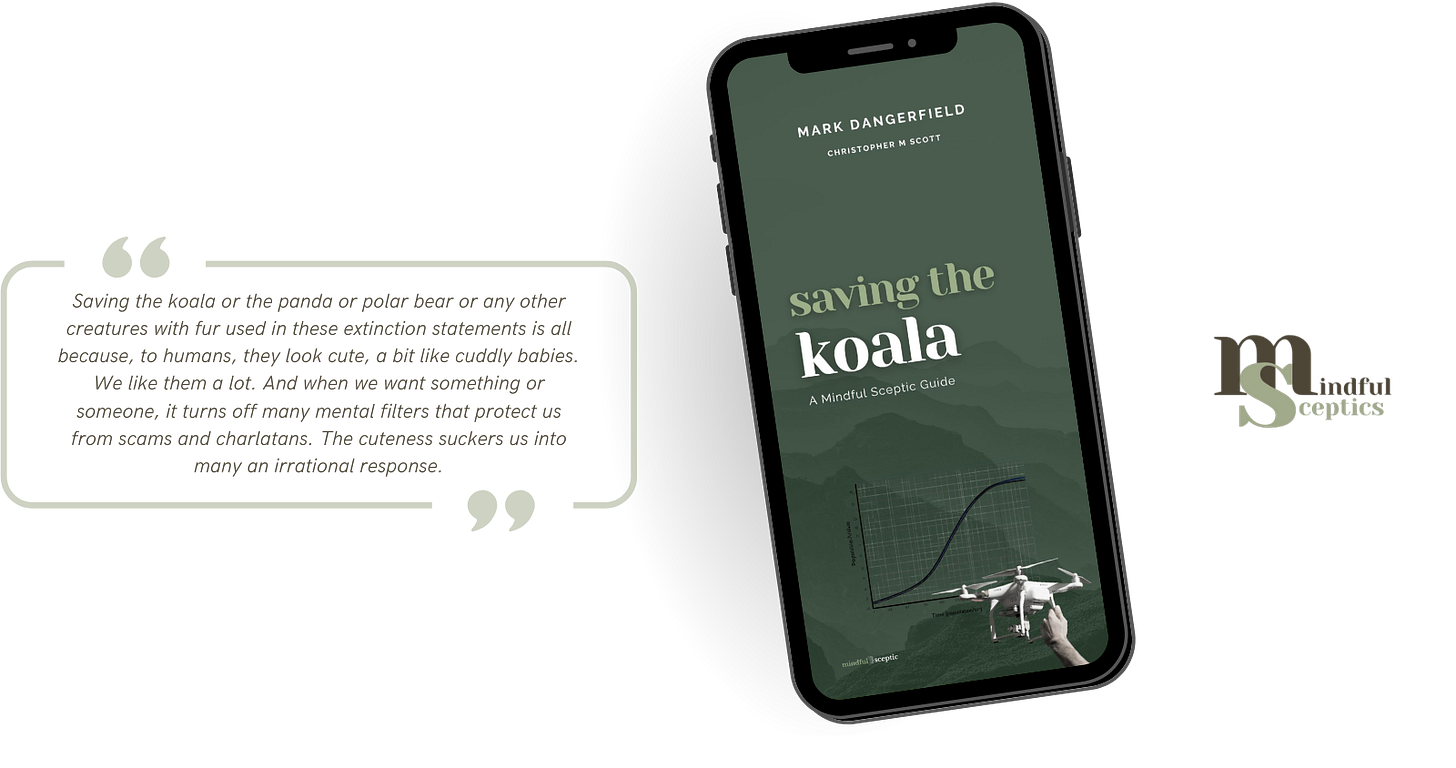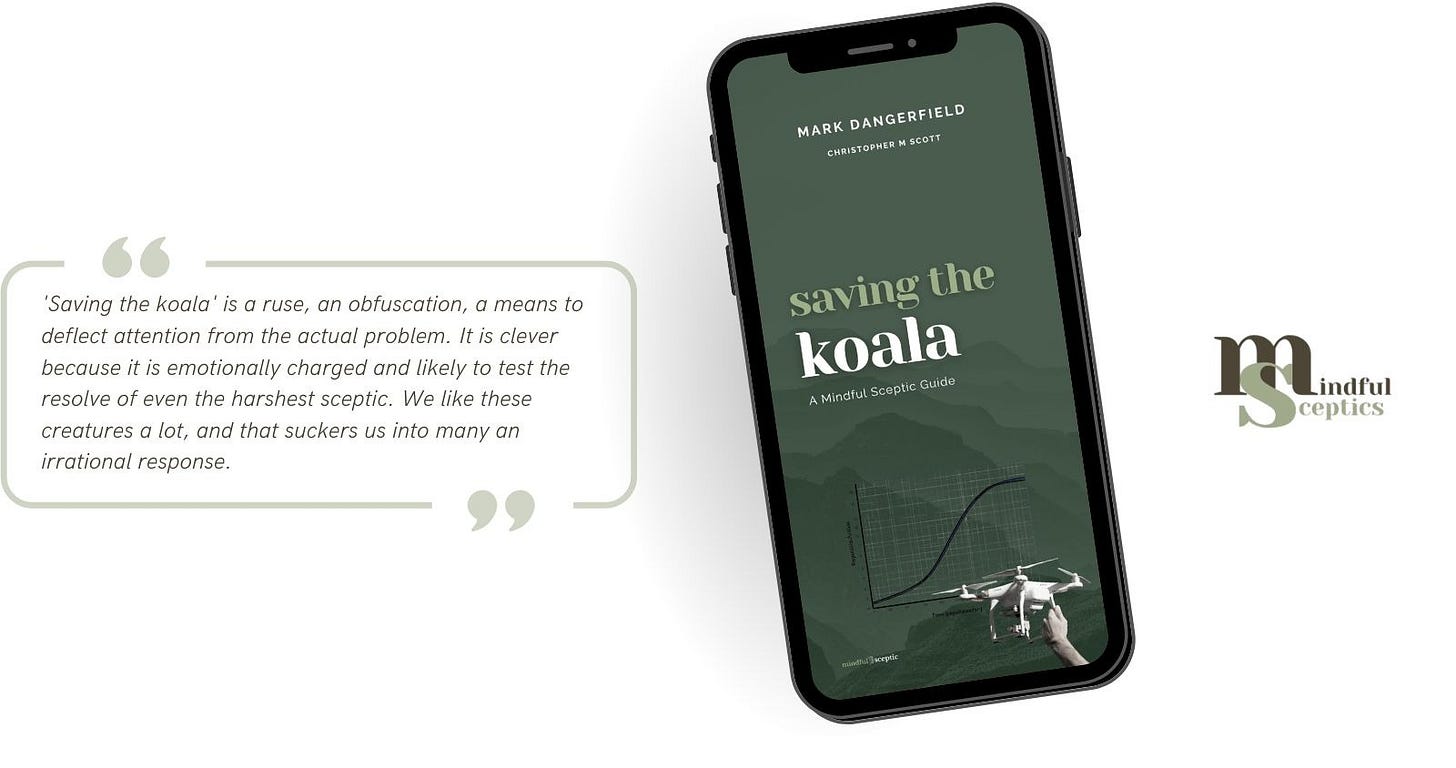Core Idea
The young volunteer with the bright t-shirt and contactless payment device has turned conservation into retail therapy. With wide eyes and a practised smile, she stands beside the poster of the cute koala while her finger hovers over the “tap to donate” machine.
This moment captures something deeply uncomfortable about modern environmentalism.
It has become an emotional manipulation industry that exploits our hardwired responses to cute animals rather than addressing the actual drivers of ecological collapse.
I know, I know, they need the money for all their great works, but really.
The conservation fundraising machine has perfected the art of turning sentiment into cash flow. Every shopping mall encounter, every social media campaign, every celebrity-endorsed petition follows the formula… identify an adorable species, manufacture urgency about its “imminent extinction,” then harvest donations from people seeking emotional relief from environmental guilt.
The bigger the eyes, the fluffier the fur, the more successful the campaign.
It’s no accident that pandas, polar bears, and koalas dominate conservation marketing while soil microbes, which actually drive ecosystem health, receive virtually no attention or funding.
This system doesn’t just prioritise the wrong species; it actively miseducates the public about how ecosystems actually function. The message is that conservation is about saving individual charismatic creatures, not about understanding the complex web of relationships that make healthy environments possible.
It’s a mess on so many levels.
Counterpoint
The harsh truth is that “saving the koala” is a ruse, an elaborate obfuscation designed to deflect attention from the economic system’s relentless conversion of living ecosystems into dead commodities.
In Australia, the koala has become conservation’s most successful marketing mascot precisely because it triggers our parental instincts. Those forward-facing eyes and fuzzy appearance activate the same neural pathways that make us want to protect human babies.
But this emotional manipulation comes with devastating consequences. While millions of dollars flow toward koala “rescue” operations, the fundamental drivers of habitat destruction, including land clearing for agriculture, mining, and urban development, continue unabated.
The conservation industry has learned that it’s far easier to extract donations by showing injured koalas in rescue centres than by confronting the land use decisions that create injured koalas in the first place.
Consider the arithmetic of deception.
When NRMA Insurance, a respected Australian brand, promised to plant trees “to ensure the future of koalas,“ the actual numbers revealed the absurdity. The 40,000 trees they promised represented just 0.08% of the trees damaged in a single fire season. Yet the campaign succeeded because it offered donors emotional satisfaction without requiring them to examine their own consumption patterns or challenge the economic structures driving environmental destruction.
The most insidious aspect of this manipulation is how it transforms environmental concern into a consumer choice.
Feeling bad about climate change? Buy carbon offsets.
Worried about species extinction? Adopt a koala online.
The conservation industry has commodified environmental guilt, turning ecological anxiety into a revenue stream while systematically avoiding the difficult conversations about power, economics, and systemic change that actual environmental protection requires.
This isn’t an accident.
Conservation organisations know that addressing root causes would threaten the very economic system that funds their operations through corporate partnerships and wealthy donors. It’s much safer to focus on saving cute animals than questioning why those animals need saving in the first place.
Thought Challenges
Track your emotional responses… to conservation appeals over the next month. When do you feel most compelled to donate, and what specific images, language, or stories activate that response? Compare this to appeals for less charismatic but more ecologically critical conservation work, such as soil restoration or insect habitat protection.
Research three conservation organisations’ budget breakdowns… What percentage goes to fundraising and administrative costs versus on-ground environmental work? How much of their “conservation” work involves direct habitat protection versus species-specific programs? What is the cost-per-hectare of land permanently protected compared to the cost-per-rescued-animal?
Closing Reflection
The conservation industry has mastered the art of making us feel better about ecological collapse without actually addressing its causes.
True environmental protection requires confronting uncomfortable truths about consumption, power, and economic systems. This is work that can’t be accomplished through cute animal campaigns.
The koala doesn’t need saving from extinction; our thinking needs saving from manipulation.
Evidence Support
Smith, R. J., Veríssimo, D., Isaac, N. J., & Jones, K. E. (2012). Identifying Cinderella species: uncovering mammals with conservation flagship appeal. Conservation Letters, 5(3), 205-212.
TL;DR… analyses traits that predict which mammal species are chosen as conservation “flagships,” finding that selection is driven by charisma, rarity, and anthropomorphic features, rather than ecological or conservation need. The authors show that conservation prioritisation and funding are systematically biased toward emotive, “cute” species.
Relevance to insight… foundational in empirically demonstrating that emotional and aesthetic responses, not biological urgency, drive charitable focus—reinforcing the claim that conservation fundraising exploits emotional manipulation to garner donations for iconic, charismatic animals.
Skibins, J. C., Powell, R. B., & Hallo, J. C. (2013). Charisma and conservation: Charismatic megafauna’s influence on safari and zoo tourists’ pro-conservation behaviours. Biodiversity and Conservation, 22(4), 959–982.
TL;DR… exposure to charismatic megafauna (like elephants and lions) in zoos and safaris affects tourists’ conservation attitudes and donation behaviours. The authors find that charisma significantly increases emotional affect, perceived moral obligation, and the willingness to donate, well beyond what is driven by factual information.
Relevance to insight… underlines how conservation organisations leverage emotional manipulation via charismatic species to elicit donations and shape public opinion, at the risk of sidelining less photogenic, but ecologically vital, organisms.
Veríssimo, D., MacMillan, D. C., & Smith, R. J. (2011). Toward a systematic approach for identifying conservation flagships. Conservation Letters, 4(1), 1–8.
TL;DR… reviews the use of “flagship species” in conservation and reveals the emotional heuristics—such as cuteness, anthropomorphism, and perceived value—that determine which species are used in conservation marketing and fundraising campaigns. The authors also critique the ethical and ecological consequences of these emotionally charged choices.
Relevance to insight… highlights, in a systematic and critical manner, the manipulation of public sentiment as a conservation strategy, supporting the argument that emotional appeal is often prioritised over scientific need.
These studies and dozens more provide robust, peer-reviewed evidence that conservation organisations frequently leverage emotional manipulation to attract public attention and fundraising, often decoupling conservation marketing from ecological reality or stewardship needs.






